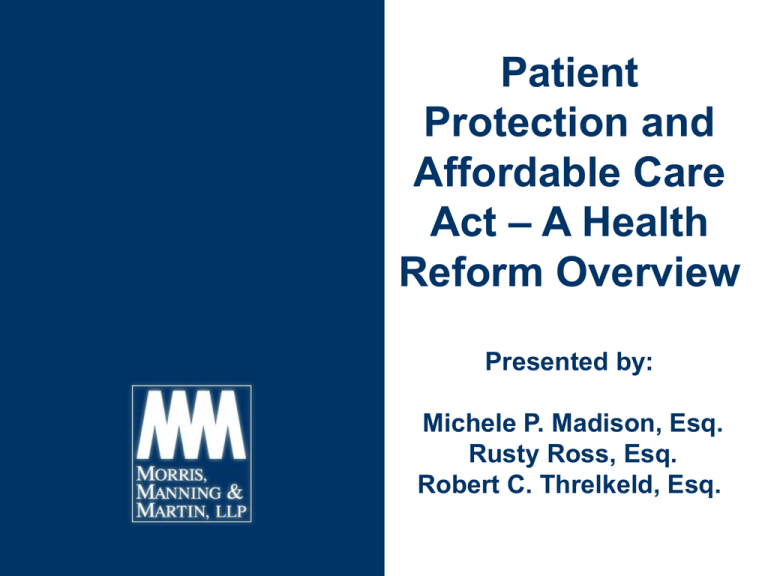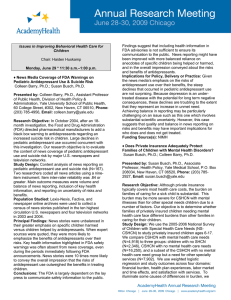Patient Protection and Affordable Care Act – A
advertisement

Patient Protection and Affordable Care Act – A Health Reform Overview Presented by: Michele P. Madison, Esq. Rusty Ross, Esq. Robert C. Threlkeld, Esq. Overview • Health Care Reform legislation enacted March 23, 2010; amended March 26, 2010 • Sponsors a system of state based health insurance exchanges • Expands health insurance coverage to a number of individuals • Reforms Medicare reimbursement methodologies for providers • Expanding eligibility to the Medicaid program • Reforms insurance eligibility standards • Enhances enforcement of fraud and abuse laws Insurance Market Reforms • Secretary of HHS will define essential benefits for Plans. • Dependent Coverage until age 26 • No Rescissions- not able to rescind a health care policy once an individual is covered, except for fraud or intentional misrepresentation of a material fact by an individual. • Restrictions on Annual & Lifetime Limits- not permitted to impose lifetime limits on the dollar value of essential benefits for a participant or a beneficiary • Establishes Early Retiree Reinsurance • No restrictions on pre-existing conditions- Effective for plan years beginning 6 months after enactment for children under 19; Effective 2014- for all individuals • Establishes Process for Annual Rate Reviews • Must cover recommended preventive health without cost sharing • Must comply with nondiscrimination testing provisions that prevent discrimination based on income Temporary State High Risk Pools • Establishes Temporary State High Risk Pools for individuals with pre-existing conditions who do not have creditable coverage (Expires 1/1/2014). • Provides $5 billion in federal funds to support these pools • U.S. Department of Health and Human Services (HHS) Secretary Kathleen Sebelius 4/3/10 letter to Governor- Options for states: – Operate a new high risk pool alongside a current state high risk pool; – Establish a new high risk pool (in a state that does not currently have a high risk pool); – Build upon other existing coverage programs designed to cover high risk individuals; – Contract with a current HIPAA carrier of last resort or other carrier, to provide subsidized coverage for the eligible population; or – Do nothing, in which case HHS would carry out a coverage program in the state. • States must contact HHS indicating if they will establish a program or if they will leave it to HHS to carry out a program. – Submit the name of a primary contact person by April 9, 2010 – Submit a letter of intent by April 30, 2010 State Health Exchanges • By January 1, 2014, each state directed to establish an exchange established for the purposes of facilitating the purchase of Qualified Health Plans • If a state does not implement an exchange, then DHHS will be required to implement an insurance exchange in that State or contract with a non-profit organization to do so • Must have minimal basic coverage • Allows for variation in ratings for plans offered based on age, family composition, premium rating area, and tobacco usage Individual Responsibilities • Beginning 2014, individuals, with limited exceptions, will: – Be required to maintain “minimum essential coverage” or pay a penalty – Be eligible for federal assistance to purchase health coverage, if meet certain criteria – Be able to purchase coverage through a state-run insurance Exchange Employer Responsibilities • Applies to employers who employed an average of at least 50 FTEs on business days during the preceding calendar year (FTE = average of 30 hours per week). • Must pay a fee if coverage IS NOT offered to FTE AND any FTE receives premium assistance from federal government. – $2,000 annual fee for each full-time employee employed (minus the first 30 employees) • Must pay a fee if coverage IS offered to full time employees BUT any FTE still receives premium assistance from federal government – the lesser of $3,000 annual fee for each employee receiving premium assistance OR $2,000 annual fee per employee for each FTE Impact on False Claims Act • Expands the scope of the original source exception and makes the public disclosure bar a more flexible standard • Original Source- – eliminates the requirement for direct knowledge by the whistleblower – allows individuals to still be considered whistleblowers after public disclosure if the information is independent of and materially adds to the already-disclosed information • Public Disclosure- – limits the definition as applying only to disclosures in the news media and in federal, not state or local, proceedings • Takeaway- The Health Reform Law will significantly increase provider’s exposure to FCA lawsuits and investigations Anti-kickback & Stark • Anti-kickback Statute- clarifies that a showing of “specific intent” to violate the AKS is not required. • Stark Law – Requires DHHS to develop a self-disclosure protocol – Authorizes Sec. of DHHS to reduce repayments and penalties for Stark Act violations, depending on provider cooperation and the timeliness of the self-disclosure. • Healthcare Criminal Fraud Statute- Lowers the intent requirement such that proof of actual knowledge of the healthcare fraud statute or of specific intent to violate the statute is no longer required. Other Fraud Measures • Provider Screening- Requires the Secretary of HHS to establish procedures for screening providers based on the perceived risk of fraud, waste and abuse in each category of health care services. • Compliance Programs- Requires providers to establish compliance programs that contain core elements determined by the federal government. • Recovery Audit Contractors- Role of RACs to be expanded to the Medicare Part D and Medicare Advantage programs. Effects to Physician-Owned Hospitals • After December 31, 2010, Physicians will not be permitted to own or invest in hospitals that the physician refers patients unless the Hospital had physician ownership prior to that date and a Medicare Provider Agreement. • Effective immediately, the only way for physician-owned hospitals to update or expand their facilities while preserving their Medicare participation would be to meet narrow criteria set out by the government • Hospitals’ aggregate ownership by physicians can not increase after the date of enactment. Thus for future investment – physicians may purchase shares only from other selling physicians Disclosure Requirements • Applies to device, drug, medical supply, and biologic manufacturing companies • Requires reporting information related to payments and other transfers of value to physicians and hospitals for values of $10 or more (or $100 aggregate in a calendar year) to the Secretary of HHS. • Effective March 31, 2013 Additional Requirements for 501(c)(3) Hospitals • Community Health Needs Assessment • Financial Assistance Policy Requirement • Restrictions on Patient Charges • Limitation on Collections Practices Innovation Changes • Creation of Centers for Medicare and Medicaid Innovation (CMI) • Impact on Health Information Technology Developing tools to change the Medicare System Prevention and Wellness • Establishes the National Prevention, Health Promotion and Public Health Council • Funds State Demonstration Projects to Evaluate Wellness Programs • Requires qualified health plans to provide minimum covered services without cost sharing for preventative services • Permits employers to establish discounts up to 30 percent of premium, modify co-pays or deductibles to encourage participation in wellness programs or for meeting certain health standards Demonstration Projects • Establishes a Medicare pilot program to develop and evaluate paying a bundled payment for acute, inpatient hospital services, physician services, outpatient hospital services, and post-acute care services for an episode of care that begins three days prior to a hospitalization and spans 30 days following discharge. • Establishes a hospital value-based purchasing program in Medicare to pay hospitals based on performance on quality measures and extend the Medicare physician quality reporting initiative beyond 2010 • Supports comparative effectiveness research by establishing a nonprofit Patient-Centered Outcomes Research Institute to identify research priorities and conduct research that compares the clinical effectiveness of medical treatments. Medicare • Reduces Disproportionate Share Hospital (DSH) payments by 75% and subsequently increases such payments based on the percent of the uninsured population and the amount of uncompensated care provided by the hospital • Reduces Medicare payments for preventable hospital readmissions • In 2015, reduces Medicare payments to certain hospitals for hospital-acquired conditions by 1% • Provides a 10% bonus payment to primary care physicians and to general surgeons practicing in health professional shortage areas from 2011 through 2015 • Restructures payments to Medicare Advantage Plans • Sets imaging equipment utilization rate at 75 percent for imaging equipment costing more than $1 million beginning in 2011. Excludes nuclear cardiology services, preventing additional reimbursement cuts for the field • Closes Part D doughnut hole Medicaid • Expands coverage to all individuals under 65 with incomes up to 133% of FPL; not applicable to undocumented individuals • Increases Medicaid reimbursement to primary care physicians • Increases Medicaid drug rebates • Reduces Medicaid payment allotment to DSH hospitals Timeline Timeline Illustration Projected Funding • Higher Medicare taxes on high income individuals and families • Excise tax on expensive “Cadillac” health plans • Insurance Mandate Penalties – Individuals who don’t purchase insurance would be subject to a fine of $325 in 2015, and in 2016, the greater of (i) $695 or (ii) 2.5 percent of income. – Employers, with more than 50 employees, who do not offer health insurance coverage to its employees must pay $2,000 annually for each “full-time employee” (excluding the first 30 employees). • Fees on health care industries – Drug manufacturers – Annual fee that gradually increases from $2.5 billion to $4.1 billion by 2018, plus $2.8 billion per year thereafter – Health insurers- Close to $60 billion in fees on insurance companies (2014-2018), plus $14.3 billion per year plus adjustment thereafter – Medical device manufacturers- 2.3 % excise tax on the sale of any of devices, beginning Jan. 1, 2013. Thank you Healthcare Practice Michele Madison 404-504-7621 mmadison@mmmlaw.com Robert Threlkeld 404-504-7757 rthrelkeld@mmmlaw.com Rusty Ross 912-232-7182 jross@mmmlaw.com This presentation is provided as a general informational service to clients and friends of Morris, Manning & Martin LLP. It should not be construed as, and does not constitute, legal advice on any specific matter, nor does this message create an attorney-client relationship. These materials may be considered Attorney Advertising in some states. Please note, prior results discussed in the material do not guarantee similar outcomes.








